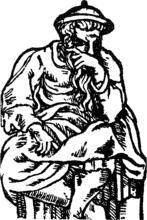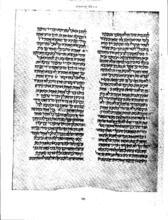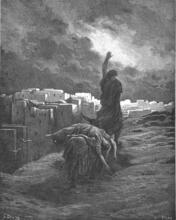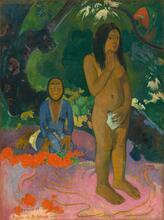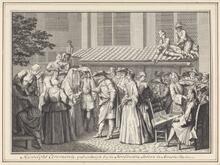Rachel, Wife of Rabbi Akiva
Rachel is the name given to the wife of Rabbi Akiva in Avot de-Rabbi Natan, a medieval aggadic text. Though she is unnamed, she appears across rabbinic literature, including in the Babylonian and Jerusalem Talmuds. Though the story differs in each version, all agree that she played a key role in her husband’s rise to prominence through great personal sacrifice. The Jerusalem Talmud depicts her as selling her hair to support her husband’s studies. The most famous version, in the Babylonian Talmud, describes her as living alone and in poverty after being disowned by her father and while Akiva mastered Torah. All of the stories about Rachel end with Rabbi Akiva rewarding her with a lavish gift.
Article
Rachel is the medieval name given to the wife of Rabbi Akiva in the late Avot de-Rabbi Nathan version A (chapter 6). In none of the older sources is a name attached to this woman, although she was well known.
Rabbi Akiva’s wife is mentioned in three separate sources. While these tell different stories about her, they agree on two details, which may represent the historical core behind the woman. All sources—The The discussions and elaborations by the amora'im of Babylon on the Mishnah between early 3rd and late 5th c. C.E.; it is the foundation of Jewish Law and has halakhic supremacy over the Jerusalem Talmud.Babylonian Talmud (Marriage document (in Aramaic) dictating husband's personal and financial obligations to his wife.Ketubbot 62b; Nedarim 50a), The The interpretations and elaborations of the Mishnah by the amora'im in the academies of Erez Israel. Editing completed c. 500 C.E.Jerusalem Talmud (SabbathShabbat 6:1; Suspected adulteressSotah 9:15) and Avot de-Rabbi Nathan (Version A, chapter 6; Version B chapter 12)—agree that Rabbi Akiva’s wife was in some way instrumental in her husband’s rise to prominence. He began his life as a pauper and through her agency became learned and rich. In addition, all the sources know that her husband rewarded her for her troubles with a glamorous headdress usually identified as a golden city, or a golden Jerusalem (see also BT Shabbat 59a–b).
Aside from these two details, the sources tell different stories about how Akiva’s wife helped her husband, and in some details contradict one another. The Babylonian Talmud relates that Rabbi Akiva was a shepherd employed by the rich Jerusalem magnate Ben Kalba Savu’a. His daughter saw Akiva, recognized his hidden qualities and proposed to him on condition that he go and study. This resulted in her father’s disowning her. Disowned by her father and deserted by her husband, Akiva’s wife was left to fend for herself for twenty-four years, until finally her husband returned in glory and recognized his wife’s role in his success, saying to his disciples: “Mine and yours are hers.” This story, told twice in the BT, seems to contradict itself in some details. In one of the versions Akiva’s studies are presented as a condition without the fulfillment of which no marriage will take place (BT Ketubbot 62b). Thus Akiva goes off to study after betrothal, but without consummation. In the other version (BT Nedarim 50a) Akiva sets out on his studies only after the couple has lived in poverty for some time.
In any case, both versions contradict the stories of Akiva’s wife told in the JT and in Avot de-Rabbi Nathan and pose chronological complications. If Rabbi Akiva died a martyr’s death in the aftermath of the Bar Kokhba revolt (135 CE), it is not very likely that he was an employee of the Jerusalem millionaire of 66 CE, who, according to legend, could supply the city with food for twenty years but lost all his riches when armed bands burnt the food supplies in besieged Jerusalem (BT Writ of (religious) divorceGittin 56a). Thus one should conclude that the BT story is legendary and was composed for didactic purposes, primarily in order to justify husbands in Babylonia leaving their wives at home for protracted periods of time in order to study Torah she-bi-khetav: Lit. "the written Torah." The Bible; the Pentateuch; Tanakh (the Pentateuch, Prophets and Hagiographia)Torah. Perhaps the true father of Akiva’s wife was a certain Joshua, whose son, Rabbi Yohanan, is described in one source as “Rabbi Johanan, son of Joshua, Rabbi Akiva’s father-in-law” (Codification of basic Jewish Oral Law; edited and arranged by R. Judah ha-Nasi c. 200 C.E.Mishnah Yadayim 3:5). Rabbi Akiva’s son was certainly called Joshua ((Aramaic) A work containing a collection of tanna'itic beraitot, organized into a series of tractates each of which parallels a tractate of the Mishnah.Tosefta Ketubbot 4:7), probably after his grandfather.
In the Jerusalem Talmud, a completely different story is related about the help Akiva’s wife rendered her husband. According to this version, she sold her hair and thus supplied him with the funds for his study. Apparently women’s hair was a real commodity and could become a source of income for women at the time (e.g. Mishnah Arakhin 1:4) but women’s selling their hair is a very common and also an ancient literary motif (see the apocryphal Testament of Job 23:7–10). Furthermore, the story of the sale of hair serves the literary strategy of measure for measure. Akiva’s wife sold her hair in order to assist her husband, and he later rewarded her with a magnificent headdress.
The Jerusalem Talmud version, which tells of the economic assistance that Rabbi Akiva’s wife rendered her husband, does not involve the husband’s long absence from home. In this it disagrees with the Babylonian version. The third version of the story, found in the two editions of Avot de-Rabbi Nathan, seems to reject the stories of both the Babylonian Talmud and the Jerusalem Talmud. It relates how Rabbi Akiva started off as a pauper and an ignoramus, deciding on his own initiative to go and study. He already had an adult son when he began school. While he was learning he also supported himself economically. Yet the story ends with Rabbi Akiva buying his wife a golden crown; when questioned about the inappropriateness of his actions, he responds by claiming that his wife too had “suffered much with me in the Torah.”
Only in Avot de-Rabbi Nathan version A (the later version of this A type of non-halakhic literary activitiy of the Rabbis for interpreting non-legal material according to special principles of interpretation (hermeneutical rules).midrash), is the name Rachel found. It seems to be based on a misreading of the text in BT Ketubbot 62b, where we are informed that Rabbi Akiva’s daughter had acted like her mother with regard to her husband—Simeon Ben Azzai—obviously allowing him to go away on his studies for a lengthy period. This statement is followed by a saying intended to describe the daughter’s actions, the sheep went after the sheep. The word rakhila means sheep and the name Rachel is derived from the same root. Avot de-Rabbi Nathan interpreted the saying as naming the woman.
Aderet, Avraham. “The
Story in Sefer ha-Aggadah B.”
(Hebrew) Alei
Siah 4–5 (1978): 122–39.
This article gives an insightful comparison between the two versions of Rabbi
Akiva’s wife’s story in the Babylonian Talmud, arguing for the primacy of
the BT Ketubbot
62b version.
Boyarin, Daniel. Carnal
Israel: Reading Sex in Talmudic Culture. Berkeley: 1993: 134–66.
Boyarin is interested in cultural critique. This chapter in his book is the
most complete argument for the story of Rabbi Akiva’s wife serving as a founding
myth for the studying husband and working wife ethos in Jewish tradition.
Cohen, Aryeh. Rereading
Talmud: Gender, Law and Poetics of Sugyot. Atlanta: 1998 97–130.
Cohen’s study is devoted to reading talmudic discourses as whole literary
unites. In this chapter he suggests reading the BT Ketubbot
62b discourse as a rabbinic attempt to substitute the wife with the
study-house. The story of Rabbi Akiva’s wife serves, in his opinion as the
apex of this approach in which, in the end she is left faceless, powerless
and nameless.
Fraenkel, Yona. Studies
in the Spiritual World of the Aggadic Story (Hebrew). Tel Aviv: 1981:
99–115.
Fraenkel’s study is primarily interested in assessing the literary qualities
of the rabbinic stories. In this chapter he compares some of the stories in
BT Ketubbot
62a with their parallels elsewhere in BT and Palestinian sources, showing
the literary distinctiveness of each story. His analysis draws attention to
the fact that the BT Ketubbot
story of Akiva’s wife does not assume a marriage between the two, prior to
his studies.
Ilan, Tal. Mine
and Yours are Hers: Retrieving Women’s History from Rabbinic Literature.
Leiden: 1997.
Ilan is interested in rabbinic literature as a tool for women’s history. She
uses the stories of Rabbi Akiva’s wife in order to demonstrate reading strategies
in rabbinic literature designed to identify historical information embedded
therein.
Kagan, Tsipora. “The
Faithful Woman in Folklore,”
(Hebrew) Mahanaim
98 (1965): 144–149.
This is a folkloristic study. Kagan places the stories of Rabbi Akiva’s wife
within the context of repeated international folk motifs of wives sacrificing
their limbs to help their men.
Sered, Susan Starr. “A Tale of Three Rachels, or the Cultural Herstory of
a Symbol,” Nashim:
A Journal of Jewish Women’s Studies and Gender Issues 1 (1998): 5–41.
Sered is an anthropologist. This study places Rabbi Akiva’s wife as a figure
for religious veneration and piety in the context of the name Rachel attached
to it, and its subsequent relationship to other women named Rachel in Jewish
tradition.
Valler, Shulamit, Women
and Womanhood in the Stories of the Babylonian Talmud. Atlanta: 1999.
This study is interested in chains of stories on women in the Babylonian Talmud.
Valler claims that these chains of stories are designed to counter restrictive
halakhah on women. In her opinion, the stories in BT
Ketubbot 62 are intended to instruct the reader that for the husband
to follow alone the halakhic preference of Torah study, without consent of
his wife is foolish and dangerous.

